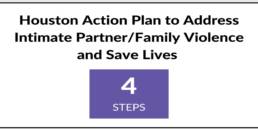Premise: Violence is preventable. In most domestic violence homicide cases, there was an opportunity to intervene and change the outcome. In 2019, nearly 40% of the people killed by domestic violence in Texas were in the process of leaving or had left the relationship. We want to identify those moments of opportunity, alter the intervention, and save lives. It takes the entire community to do it. And it can be done. Harris County has the most domestic violence deaths by guns. Removing guns from abusers saves lives. Part of our intervention needs to focuson reducing access to guns for known offenders.
1. Enforce Local Gun Safety Laws –
- Agree on, fund, and fully implement gun surrender laws already on the books for known offenders and for those with protective orders, with every arm of Law Enforcement.
2. Increase safety for survivors –
- Fund and implement a citywide Domestic Abuse Response Teams – cross-functional teams including HPD, victim advocates and forensic nurses to ensure evidence is collected and victim’s safety is secured. Integrate with the Hi-Risk teams.
- Partner with complete communities to locate domestic violence support services in multi-service centers to improve access in high–need areas, and integrate with the high–risk teams.
-
Ensure all survivors are provided an advocate at the 280th Protective Order Court to help them obtain a protective order and increase likelihood of them staying engaged in the legal process.
- Fund safety on–demand for survivors and address turn away numbers.
3. Improve Accountability for offenders
- Educate judges on domestic violence and its impact in the community and their judicial authority to intervene and save lives.
- Arrest offenders for violating a protective order and gun possession laws.
- Support survivors to stay engaged with a system–based and community–based advocate, and a wrap–around, victim–centered approach.
- Prosecute offenders in a timely manner.
4. Advance violence prevention framework
- Partner with and train local media in how to understand, explain and present stories to help prevent violence from happening RATHER than establish it as a community norm.
- Train stakeholders in a multi-service center, skills–based curriculum to help the community Recognize, Respond and Refer.
- Implement a community-wide public information campaign.

